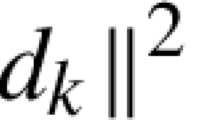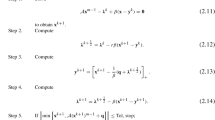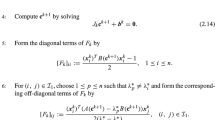Abstract
An increasing number of applications are based on the manipulation of higher-order tensors. In this paper, we derive a differential-geometric Newton method for computing the best rank-(R 1, R 2, R 3) approximation of a third-order tensor. The generalization to tensors of order higher than three is straightforward. We illustrate the fast quadratic convergence of the algorithm in a neighborhood of the solution and compare it with the known higher-order orthogonal iteration (De Lathauwer et al., SIAM J Matrix Anal Appl 21(4):1324–1342, 2000). This kind of algorithms are useful for many problems.
Similar content being viewed by others
References
Absil, P.A., Ishteva, M., De Lathauwer, L., Van Huffel, S.: A geometric Newton method for Oja’s vector field. (Accepted for publication in Neural Computation). doi:10.1162/neco.2008.04-08-749 (2008)
Absil, P.A., Mahony, R., Sepulchre, R.: Optimization Algorithms on Matrix Manifolds. Princeton University Press, Princeton (2008)
Acar, E., Bingol, C.A., Bingol, H., Bro, R., Yener, B.: Multiway analysis of epilepsy tensors. Bioinformatics 23(13), i10–i18 (2007) (ISMB 2007 Conference Proceedings)
Adler, R.L., Dedieu, J.P., Margulies, J.Y., Martens, M., Shub, M.: Newton’s method on Riemannian manifolds and a geometric model for the human spine. IMA J. Numer. Anal. 22(3), 359–390 (2002)
Alvarez, F., Bolte, J., Munier, J.: A unifying local convergence result for Newton’s method in Riemannian manifolds. Found. Comput. Math. 8(2), 197–226 (2008)
Baranyi, P., Varkonyi-Koczy, A.R., Yam, Y., Patton, R.J.: Adaptation of TS fuzzy models without complexity expansion: HOSVD-based approach. IEEE Trans. Inst. Meas. 54(1), 52–60 (2005)
Carroll, J., Chang, J.: Analysis of individual differences in multidimensional scaling via an N-way generalization of “Eckart-Young” decomposition. Psychometrika 35(3), 283–319 (1970)
Comon, P.: Independent component analysis, a new concept? Signal Process. 36(3), 287–314 (1994) (Special Issue on Higher-order Statistics)
Comon, P.: Tensor decompositions. In: McWhirter, J.G., Proudler, I.K. (eds.) Mathematics in Signal Processing V, pp. 1–24. Clarendon, Oxford (2002)
De Lathauwer, L.: A link between the canonical decomposition in multilinear algebra and simultaneous matrix diagonalization. SIAM J. Matrix Anal. Appl. 28(3), 642–666 (2006)
De Lathauwer, L.: Decompositions of a higher-order tensor in block terms—part I: lemmas for partitioned matrices. SIAM J. Matrix Anal. Appl. 30(3), 1022–1032 (2008) (Special Issue on Tensor Decompositions and Applications)
De Lathauwer, L.: Decompositions of a higher-order tensor in block terms—part II: definitions and uniqueness. SIAM J. Matrix Anal. Appl. 30(3), 1033–1066 (2008) (Special Issue on Tensor Decompositions and Applications)
De Lathauwer, L., Castaing, J.: Tensor-based techniques for the blind separation of DS-CDMA signals. Signal Process. 87(2), 322–336 (2007) (Special Issue on Tensor Signal Processing)
De Lathauwer, L., De Moor, B., Vandewalle, J.: A multilinear singular value decomposition. SIAM J. Matrix Anal. Appl. 21(4), 1253–1278 (2000)
De Lathauwer, L., De Moor, B., Vandewalle, J.: On the best rank-1 and rank-(R 1, R 2,...,R N ) approximation of higher-order tensors. SIAM J. Matrix Anal. Appl. 21(4), 1324–1342 (2000)
De Lathauwer, L., De Moor, B., Vandewalle, J.: Independent component analysis and (simultaneous) third-order tensor diagonalization. IEEE Trans. Signal Process. 49(10), 2262–2271 (2001)
De Lathauwer, L., De Moor, B., Vandewalle, J.: Computation of the canonical decomposition by means of a simultaneous generalized Schur decomposition. SIAM J. Matrix Anal. Appl. 26(2), 295–327 (2004)
De Lathauwer, L., Nion, D.: Decompositions of a higher-order tensor in block terms—part III: alternating least squares algorithms. SIAM J. Matrix Anal. Appl. 30(3), 1067–1083 (2008) (Special Issue on Tensor Decompositions and Applications)
De Lathauwer, L., Vandewalle, J.: Dimensionality reduction in higher-order signal processing and rank-(R 1, R 2,...,R N ) reduction in multilinear algebra. Linear Algebra Appl. 391, 31–55 (2004) (Special Issue on Linear Algebra in Signal and Image Processing)
De Vos, M., De Lathauwer, L., Vanrumste, B., Van Huffel, S., Van Paesschen, W.: Canonical decomposition of ictal scalp EEG and accurate source localization: principles and simulation study. J. Comput. Intell. Neurosci. 2007(Article ID 58253), 1–10 (2007) (Special Issue on EEG/MEG Signal Processing)
De Vos, M., Vergult, A., De Lathauwer, L., De Clercq, W., Van Huffel, S., Dupont, P., Palmini, A., Van Paesschen, W.: Canonical decomposition of ictal scalp EEG reliably detects the seizure onset zone. NeuroImage 37(3), 844–854 (2007)
Dedieu, J.P., Priouret, P., Malajovich, G.: Newton’s method on Riemannian manifolds: covariant alpha theory. IMA J. Numer. Anal. 23(3), 395–419 (2003)
Edelman, A., Arias, T.A., Smith, S.T.: The geometry of algorithms with orthogonality constraints. SIAM J. Matrix Anal. Appl. 20, 303–353 (1998)
Elad, M., Milanfar, P., Golub, G.H.: Shape from moments—an estimation theory perspective. IEEE Trans. Signal Process. 52, 1814–1829 (2004)
Eldén, L., Savas, B.: A Newton–Grassmann method for computing the best multi-linear rank-(r 1, r 2, r 3) approximation of a tensor. Tech. Rep. LITH-MAT-R-2007-6-SE, Department of Mathematics, Linköpings Universitet (2007)
Golub, G.H., Van Loan, C.F.: Matrix Computations, 3rd edn. Johns Hopkins University Press, Baltimore (1996)
Harshman, R.A.: Foundations of the PARAFAC procedure: model and conditions for an “explanatory” multi-mode factor analysis. UCLA Work. Pap. Phon. 16(1), 1–84 (1970)
Helmke, U., Moore, J.B.: Optimization and Dynamical Systems. Springer, New York (1994)
Hitchcock, F.L.: The expression of a tensor or a polyadic as a sum of products. J. Math. Phys. 6(1), 164–189 (1927)
Hitchcock, F.L.: Multiple invariants and generalized rank of a p-way matrix or tensor. J. Math. Phys. 7(1), 39–79 (1927)
Khoromskij, B.N., Khoromskaia, V.: Low rank Tucker-type tensor approximation to classical potentials. Cent. Eur. J. Math. 5(3), 523–550 (2007)
Kolda, T.: Orthogonal tensor decompositions. SIAM J. Matrix Anal. Appl. 23, 243–255 (2001)
Kroonenberg, P.M.: Applied Multiway Data Analysis. Wiley, New York (2008)
Kroonenberg, P.M., de Leeuw, J.: Principal component analysis of three-mode data by means of alternating least squares algorithms. Psychometrika 45(1), 69–97 (1980)
Li, C., Wang, J.: Newton’s method on Riemannian manifolds: Smale’s point estimate theory under the γ-condition. IMA J. Numer. Anal. 26(2), 228–251 (2006)
Moravitz Martin, C.D., Van Loan, C.F.: A Jacobi-type method for computing orthogonal tensor decompositions. SIAM J. Matrix Anal. Appl. 30, 1219–1232 (2008)
Papy, J.M., De Lathauwer, L., Van Huffel, S.: Exponential data fitting using multilinear algebra: the decimative case. Technical report 04-70, ESAT-SISTA, K.U.Leuven (2004)
Papy, J.M., De Lathauwer, L., Van Huffel, S.: Exponential data fitting using multilinear algebra: the single-channel and the multichannel case. Numer. Linear Algebra Appl. 12(8), 809–826 (2005)
Savas, B., Lim, L.H.: Best multilinear rank approximation of tensors with quasi-Newton methods on Grassmannians. Tech. Rep. LITH-MAT-R-2008-01-SE, Department of Mathematics, Linköpings Universitet (2008)
Sidiropoulos, N., Bro, R., Giannakis, G.: Parallel factor analysis in sensor array processing. IEEE Trans. Signal Process. 48, 2377–2388 (2000)
Smilde, A., Bro, R., Geladi, P.: Multi-way Analysis. Applications in the Chemical Sciences. Wiley, Chichester (2004)
Tucker, L.R.: The extension of factor analysis to three-dimensional matrices. In: Gulliksen, H., Frederiksen, N. (eds.) Contributions to Mathematical Psychology, pp. 109–127. Holt, Rinehart & Winston, New York (1964)
Tucker, L.R.: Some mathematical notes on three-mode factor analysis. Psychometrika 31, 279–311 (1966)
Udrişte, C.: Convex Functions and Optimization Methods on Riemannian Manifolds. Kluwer, Dordrecht (1994)
Vasilescu, M.A.O., Terzopoulos, D.: Multilinear subspace analysis for image ensembles. In: Proc. Computer Vision and Pattern Recognition Conf. (CVPR ’03), vol. 2, pp. 93–99. CVPR, Madison (2003)
Zhang, T., Golub, G.H.: Rank-one approximation to high order tensors. SIAM J. Matrix Anal. Appl. 23, 534–550 (2001)
Author information
Authors and Affiliations
Corresponding author
Additional information
This paper presents research results of the Belgian Network DYSCO (Dynamical Systems, Control, and Optimization), funded by the Interuniversity Attraction Poles Programme, initiated by the Belgian State, Science Policy Office. The scientific responsibility rests with its authors. Research supported by: (1) Research Council K.U.Leuven: GOA-Ambiorics, CoE EF/05/006 Optimization in Engineering (OPTEC), (2) F.W.O.: (a) project G.0321.06, (b) Research Communities ICCoS, ANMMM and MLDM, (3) the Belgian Federal Science Policy Office: IUAP P6/04 (DYSCO, “Dynamical systems, control and optimization”, 2007–2011), (4) EU: ERNSI. M. Ishteva is supported by a K.U.Leuven doctoral scholarship (OE/06/25, OE/07/17, OE/08/007), L. De Lathauwer is supported by “Impulsfinanciering Campus Kortrijk (2007–2012)(CIF1)” and STRT1/08/023.
Rights and permissions
About this article
Cite this article
Ishteva, M., De Lathauwer, L., Absil, PA. et al. Differential-geometric Newton method for the best rank-(R 1, R 2, R 3) approximation of tensors. Numer Algor 51, 179–194 (2009). https://doi.org/10.1007/s11075-008-9251-2
Received:
Accepted:
Published:
Issue Date:
DOI: https://doi.org/10.1007/s11075-008-9251-2




